Shotgun Pattern Testing
Another
test conducted by firearm examiners is known as Shotgun Pattern Testing.
This test involves shotguns and allows for a muzzle-to-target
distance to be determined.
Shotgun
pattern testing involves examining evidence for a pattern of holes
created by the pellets fired from a shotgun. The
"unknown" pattern is then compared to "test" patterns created
with the suspect shotgun fired at known distances. This will allow
for an approximate muzzle-to-target distance to be
determined.
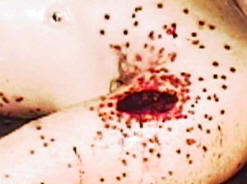
Two overlapping shot patterns. A large
dispersed
pattern overlaps a small close-range shot pattern.
When a
shotgun is fired using a multiple pellet shotshell, the pellets exit the
barrel of the shotgun and begin to spread out into a pattern that
increases in diameter as the distance increases between the pellets and
the shotgun.
To better
understand the principles involved in shotgun pattern testing it's
important to first learn a little about shotguns and the shotshells they
fire.
Shotguns
are firearms typically fired from the shoulder that are designed to fire
shotshells containing anywhere from one large projectile to as many as
several hundred small pellets. Shotguns
aren't classified by caliber but come in different gauges.
The gauge of a shotgun is determined by the number of round lead
balls of bore diameter that it takes to equal one pound. Shotguns
can come in 10, 12, 16, 20, 28, and .410 gauge. The .410 is
actually an exception with .410 referring to the caliber of the
shotgun's bore. It would actually be about a 67 gauge in
"lead ball" terms.
Although
some newer shotgun barrels are produced with rifling, shotguns have
traditionally had smooth bored barrels. Except in some rare cases
the projectiles fired from them cannot be matched back to the shotgun.
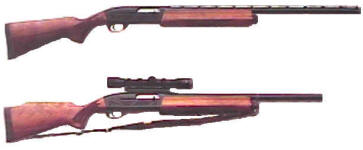
Auto loading shotgun with conventional
barrel (top) and
an auto loading shotgun with a rifled "slug" barrel (bottom).
Shotguns
come in a number of different styles and actions. From auto
loading shotguns like those seen above to very "customized"
versions like the one below.

"Sawed-off" pump-action
shotgun.
Shotguns
are typically manufactured with what is called a choke in
their barrels. A choke is a constriction in the last couple of
inches in the barrel and can vary in the degree of constriction.
Common choke designations are "full", "modified",
and "improved cylinder." A barrel that has no choke is
referred to as a cylinder-bore barrel.
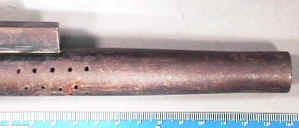
Barrel modified for use in a
"Turkey-Shoot" competition.
Extreme constriction or choke can be seen at the muzzle.
Shotguns can be manufactured with a permanent
fixed choke or can have the muzzle of the barrel machined in a
way to accept interchangeable or adjustable choke
tubes. Shotguns that have had their barrels sawed off have had
their choke removed. This creates a shotgun with a
cylinder-bore barrel.
The whole
point to this "choke thing" is that the choke plays an important role
in the rate at which the shot pellets spread as they travel away from
the shotgun. A full-choke barrel will tend to shoot smaller shot
patterns at a given distance than a barrel with a modified-choke.
Shotshells
are cartridges designed to be fired in shotguns and can contain a single
large projectile - a slug - or as many as several hundred small
spherical pellets called shot. Shot used in
shotshells has traditionally been made of lead but because
of it's toxicity, other materials are being used as a
substitute, with the most common alternative being steel.
The size of the shot can vary as can the total weight of the shot
loaded into a shotshell. Shot comes in two basic varieties, small
pellets commonly referred to as birdshot and larger
pellets called buckshot.

Components from a typical shotshell
containing
birdshot and a one-piece plastic wad.
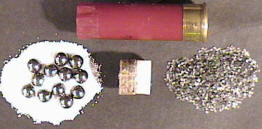
Components from a typical shotshell
containing
buckshot and a fiber/plastic wad combination.
Lead
birdshot
comes in 12, 11, 9, 8 1/2, 8, 7 1/2, 6, 5, 4, 2, and BB sizes. As the
numbers get smaller the diameter of the shot gets larger. Buckshot on
the other had comes in 4, 3, 2, 1, 0, 00, and 000. Again, as the
number decreases the diameter increases. See the chart below.
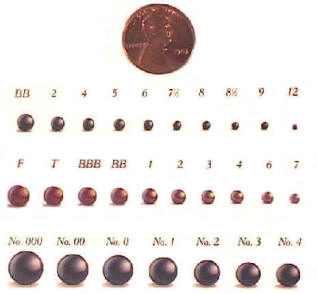
Shot size table: lead shot (top), steel
shot
(middle) and buckshot (bottom).
As you can
see from the above chart, steel shot comes in slightly larger sizes than
lead shot. Steel doesn't have the density of lead and larger shot
is needed to achieve a range comparable to that of lead shot.
Shotshells
contain a variety of different wads - plastic, paper, or
fiber material designed to separate the shot from the gunpowder and/or
protect the shot as it is
pushed down the barrel - that are expelled from the
shotshell, along with the shot, when fired.
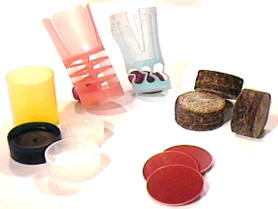
Various plastic and fiber shotshell
wads.
Shotshells
come in a variety of loads. The amount of gunpowder in a shotshell
can vary and the measurement is referred to by as the dram equivalent.
The dram equivalent is the amount of smokeless powder that produces a
velocity comparable to that of black powder.
All of these variables
are important in determining a given shot pattern distance.
When a shotgun is fired the shot and wadding
travel down the barrel and exit the muzzle in a concentrated
mass.
As a
result a contact entrance hole will produce a large hole with
significant damage to the margins of the hole, but can vary greatly
depending on the material being fired into. The same thing also applies to
gunshot residue deposits. Most contact entrance
holes will have a significant deposit of gunshot residues like the one
seen below, but this is not always the case. Some may display very
little visible gunshot residue.
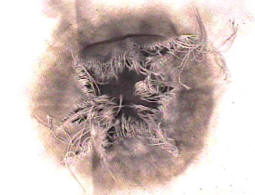
Contact shotgun entrance hole.
A hole
like the one above will be processed chemically like that previously
described on the Distance Determination/Gunshot Residue pages.
At ranges
of around 5-10 feet* the shot and wadding mass will produce a single
large hole in a target. If the target happens to be a person, the
wadding material will be blown into the wound tract with the pellets.
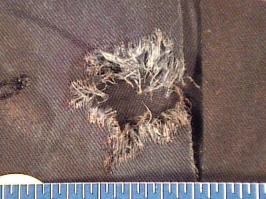
Close-range shotshell pellet entrance
hole.
The close-range entrance (less than 5 feet*)hole
seen above is almost square, and is a common shape for this
range. You might notice a pinkish color (lead residue) to
the material around the hole.
At
distances greater than 5-10 feet* the shot mass starts to break up. Fliers
(individual
pellet holes) will start to appear around the edge of an entrance hole and the
wadding may or may not enter the victim.
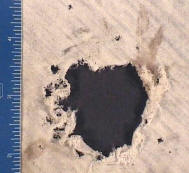
Individual pellets starting to break
apart from the main mass of pellets.
As the
wadding slows down it will start to take a separate trajectory from that of the shot
and can actually leave abrasions or bruises to the area
around an entrance wound. Wadding will lose its energy and fall
harmlessly to the ground at distances of around 20 feet*.
As the
pellets get further and further away from the shotgun the pattern will
eventually become dispersed to the point that only individual pellet
holes are present in a target.
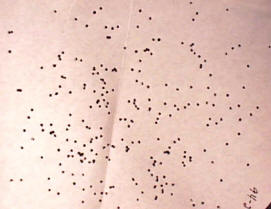
Witness panel fired into at a
distance of 28 feet.
Firearm examiners will try to reproduce the
pattern by firing into witness panels at known distances. Shot
patterns can be affected by the load, pellet size, wad type, and
choke of the shotgun. That is why it is essential that the
shotgun is recovered and the type of shotshells used is known.
Hopefully some shotshells will be recovered at the scene that
can later be used in firing the distance standards. Also,
patterns produced by a shotgun at any given distance can vary
slightly. Multiple tests patterns will be fired at known
distances and compared directly to the pattern in question.
Based on this comparison a minimum and maximum firing distance
can be determined.
Unlike the tests conducted on clothing for gunshot
residues, shotgun pattern testing is not limited to distances of
a few feet or less.
*All
distances are approximate values and can vary depending on the shotgun's
gauge/choke and ammunition used.
|